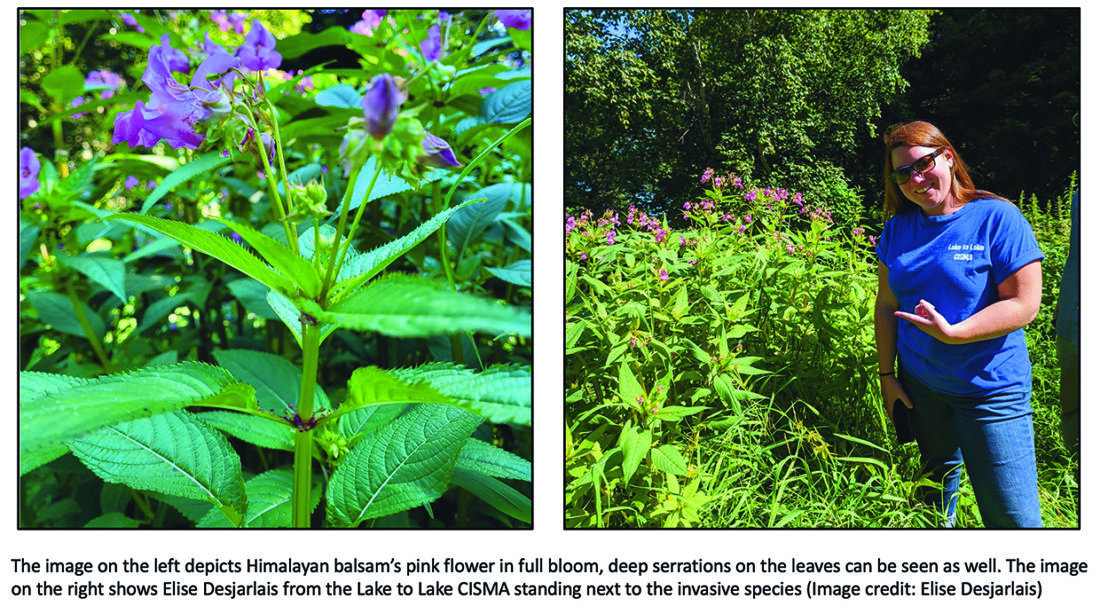Keep an eye out for early detection of this Michigan watch list invader
Himalayan Balsam (Impatiens glandulifera)

Plants get moved around on purpose or by accident, but some of them bring drastic changes to ecosystems and damage our economy. Yes, we mean invasive species. With new invasive species filtering into Michigan’s Upper Peninsula, now is the perfect time to learn about Michigan’s watch list species.
WHAT IS A WATCH LIST SPECIES?
A watch list species is a species that is “identified as posing an immediate or potential threat to Michigan’s economy, environment or human health” as defined by Michigan.gov.
The Keweenaw Invasive Species Management Area (KISMA) encourages everyone to familiarize themselves with Michigan’s watch list species (www.michigan.gov/invasives/id-report/watchlist).
One watch list plant in particular is on our minds: Himalayan balsam (Impatiens glandulifera) (www.michigan.gov/invasives/id-report/plants/herbs/himalayan-balsam). This species was first found in Michigan in the eastern Upper Peninsula (UP) in 2016, and last year was found even closer to the Keweenaw in Alger Co., so it is being moved this way. Knowing how to prevent its spread and how to identify it for early detection and management will be key to protecting our local environment and economy.
IDENTIFICATION
Himalayan balsam is within the same family as our native jewelweed (Impatiens capensis), which is a UP fan favorite, wetland plant due to its “explosive” or popping seeds and beautiful orange flowers. Jewelweed and Himalayan balsam strongly resemble each other, but there are many distinctions between the two species.
Both species inhabit riparian and wetland areas while Himalayan balsam can invade just about anywhere. Both species are also known to have popping seeds, while Himalayan balsam tends to disperse its seeds much farther than jewelweed. The main difference between jewelweed and Himalayan balsam is that jewelweed has orange flowers and Himalayan balsam will usually have pink flowers.
Some other ways you can identify Himalayan balsam:
• Grows between 3-6 feet tall
• Leaves arranged in whorls of 3 along smooth red/purple stem
• Leaves are lance-shaped and heavily serrated with deep venation compared with those of native jewelweed
• 5-petal flowers that are bright pink or light pink (sometimes white)
• Ripe seed pods explode when touched (advised not to touch to reduce seed spread)
Invasive species like Himalayan balsam are known to displace native species and change ecosystem services such as clean water and soil stabilization. This plant has very shallow roots that do not protect the soil, which means infestations of Himalayan balsam make an area susceptible to soil erosion and more invasions.
MANAGEMENT
Himalayan balsam can easily be hand-pulled as the shallow roots do not put up a fight! Larger populations might call for more involved management, so catching it early is better. It is best to manage the plant just after flowering but before going to seed for easy identification. If management must be done after going to seed, it is critical to not touch the ripe seed pods as this will disperse them even more. Once the species is removed, it is important to bag all plant material and dispose of it in the trash.
WHAT CAN YOU DO?
“The biggest thing to reduce the spread [of Himalayan Balsam] is realizing that humans are spreading it. Being aware of the flowers we put in our gardens is critical,” according to Elise Desjarlais, the coordinator of Lake to Lake Cooperative Invasive Species Management Area (CISMA) out of Marquette. Knowing what plant species are invasive, could prevent the next invasion. The local Wild Ones Keweenaw chapter can help with native garden suggestions (https://keweenaw.wildones.org/)
The most important part of invasive species prevention is education and reporting! Familiarizing yourself with priority invasive plants locally (www.mtu.edu/kisma/) and watch list species is a great way to detect new invasions early on. Catching invasions early allows for more efficient management.
To report invasive species: kisma.up@gmail.com
Midwest Invasive Species Information Network (MISIN) online reporting tool (www.misin.msu.edu/report/misin/?project=misin)
your local CISMA (www.michigan.gov/invasives/take-action/local-resources/view-cisma-locations-as-a-list)





